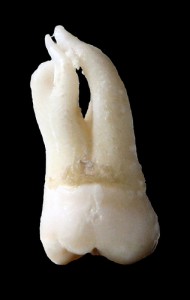 The tooth is a mineral-rich structure located in the mouth and jaw. Sizes vary between different species. The tooth has many purposes; it can be used to physically break down food to facilitate easier digestion. In carnivores, a specialized enlarged tooth known as canines is used for hunting, it is used to clamp down the throat of the prey, blocking respiration and causing as asphyxiation or the severe deficit of oxygen in the body. The tooth can be also used for defensive purposes.
The tooth is a mineral-rich structure located in the mouth and jaw. Sizes vary between different species. The tooth has many purposes; it can be used to physically break down food to facilitate easier digestion. In carnivores, a specialized enlarged tooth known as canines is used for hunting, it is used to clamp down the throat of the prey, blocking respiration and causing as asphyxiation or the severe deficit of oxygen in the body. The tooth can be also used for defensive purposes.
In humans, the tooth functions in physical break down of food. The root of the tooth is embedded in the upper jaw also known as maxilla and lower jaw or mandible. The teeth in human mouth are classified as incisors, canines, premolars and molars. Incisors are generally used for biting and tearing food items, while molars are used for grinding down food. Human canines are short and undeveloped compared to animal canines; they are remnants of human evolution from primate ancestors.
Human tooth is composed of different layers such as enamel, dentin, cementum and the dental pulp. The outermost layer is known as the enamel, it is the hardest and most mineralized structure in the human body. It is made up of different mineral; hydroxyapatite is the primary mineral. It accounts for tooth strength and brittleness. It serves as the first layer of protection in our tooth.
Dentin is the substance between enamel and the pulp chamber. It is less mineralized and less brittle but it serves as supporting structure for dentin. Dentin is porous, yellow material and is made up of 70% inorganic material, 20% organic material, and 10% water. Because dentin is less hard than enamel, it decays more rapidly; however it still acts a protective layer.
Cementum is a specialized bone like material covering the pulp. It is composed of minerals such as hydroxyapatite, organic material such as collagen and water. It is yellowish and softer than enamel or dentin. The main function of the cementum is to provide attachment for periodontal ligaments for tooth stability.
The dental pulp or nerve of the tooth is located centrally in the tooth and is filled with soft connective tissues. There are many cells located in the pulp such as fibroblast and odontoblast which functions in tooth growth, immune system cells such as macrophages, histiocytes, white blood cells. The pulp is also connected to blood vessels and nerves. The pulp supplies the tooth with organic components and oxygen, and it also serves as a sensory organ detecting temperature and pressure.

